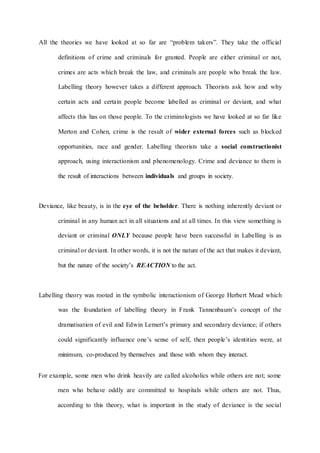
5 Minute Speech on Labelling Theory for CRM100 - Introduction to Criminology
- 1. All the theories we have looked at so far are “problem takers”. They take the official definitions of crime and criminals for granted. People are either criminal or not, crimes are acts which break the law, and criminals are people who break the law. Labelling theory however takes a different approach. Theorists ask how and why certain acts and certain people become labelled as criminal or deviant, and what affects this has on those people. To the criminologists we have looked at so far like Merton and Cohen, crime is the result of wider external forces such as blocked opportunities, race and gender. Labelling theorists take a social constructionist approach, using interactionism and phenomenology. Crime and deviance to them is the result of interactions between individuals and groups in society. Deviance, like beauty, is in the eye of the beholder. There is nothing inherently deviant or criminal in any human act in all situations and at all times. In this view something is deviant or criminal ONLY because people have been successful in Labelling is as criminal or deviant. In other words, it is not the nature of the act that makes it deviant, but the nature of the society’s REACTION to the act. Labelling theory was rooted in the symbolic interactionism of George Herbert Mead which was the foundation of labelling theory in Frank Tannenbaum’s concept of the dramatisation of evil and Edwin Lemert’s primary and secondary deviance; if others could significantly influence one’s sense of self, then people’s identities were, at minimum, co-produced by themselves and those with whom they interact. For example, some men who drink heavily are called alcoholics while others are not; some men who behave oddly are committed to hospitals while others are not. Thus, according to this theory, what is important in the study of deviance is the social
- 2. audience, not the individual person. What is important in crime is not the act of the individual but the reaction of the society. Kai Erikson (1962) has also said that what distinguishes a delinquent from a non-delinquent is not the characteristic found in him but the characteristic assigned to him by others. Street fighting is hand-to-hand combat in public places; between individuals or groups Linking this to labelling theory is a bit of a leap, as labelling theory focuses on people rather than the crime. But it is however, possible. The people or groups typically involved in street fighting have already been labelled delinquents. They have committed other crimes, in fact a study by Cullen (1974) showed that 96% of all people involved in street fighting were past offenders and labelled “delinquent”. Not only that, but the same study showed that 78% of people who are street fighters were associated with criminally labelled groups. Labelling theorists claimed that crime such as street fighting was actually made worse by criminal justice agencies’ attempts to control it because of the dramatic negative effect the system could have on individual self-identities. The new deviancy theory, as the labelling perspective of Howard Becker (1963, 1973), Edwin Schur (1965), Erving Goffman (1961) and Kai Erikson was called, showed how criminal and deviant careers were shaped progressively over time through interaction with significant others in meaningful social contexts. Adolescents constantly brought before the courts and told they were delinquents for engaging in liquor law violations, minor vandalism, and petty shoplifting would eventually become professional career criminals because the label “delinquent” restricted their abilities to mature out of the
- 3. associated behaviours and limited subsequent career options. Therefore labelling theory promotes rehabilitation rather than shaming. There is however one major criticism of labelling theory. It employs excellent logic but it does not explain the cause of crime. It entirely avoids the question of causation. References Becker, H. S. (1966). Outsiders: Studies in sociology of deviance. Free Press. Cullen, A. A. (1974). Labelling theory and social deviance. Perspectives in Psychiatric Care , 12 (3), 123-125. Erikson, K. T. (1962). Notes on the Sociology of Deviance. Social Problems , 9 (4), 307- 314.
